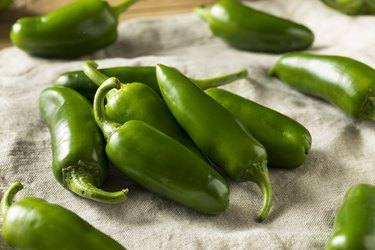
If you are a spicy food lover, then you may want to add more hot peppers to your arsenal. Serrano and jalapeño peppers have a lot in common but are also unique in many ways.
Both are Mexican peppers. They look similar in appearance, as both are small in size and green in color. The serrano is smaller than the jalapeño. Jalapeños are one of the most well known and popular peppers, but substituting serranos can add a new twist on your favorite recipes.
Video of the Day
Video of the Day
About the Jalapeño
The jalapeño is commonly used in everyday recipes. It is actually not as hot as you might believe. It is only considered a medium heat chilie. It is slightly larger than the serrano at 2.5 to 3 inches in length. They are picked and eaten while still green and not completely ripe. Once ripe, they will turn to red.
Jalapeños originate in Mexico but are also commonly grown in the United States in New Mexico and Texas. The name comes from a Mexican town where it is frequently cultivated, called Xalapa, Veracruz. Xalapa has the variant spelling "jalapa."
About the Serrano
The serrano is a less well-known pepper. It is hotter than a jalapeño and is great for adding more of a kick to spicy foods. It is about 1 to 4 inches in length and smaller than the jalapeño. They are picked and eaten when green but can ripen to red, orange, yellow or brown. They are great roasted, pan cooked or served fresh as a garnish.
Serranos originate in Mexico in the mountainous states of Puebla and Hidalgo. The name comes from the word "sierra," which means "mountain" in Spanish.
Is the Serrano or Jalapeño Hotter?
Many people wonder if the serrano or jalapeño pepper is hotter. Both peppers fall under medium heat on the Scoville scale. While jalapeño peppers are hot, the serrano is in fact hotter. A jalapeño is 2,500 to 8,000 Scoville heat units, while a serrano is 10,000 to 23,000 Scoville heat units. On average, the serrano is three times hotter than the jalapeño.
The hottest pepper is the Carolina Reaper, followed by the Trinidad Moruga Scorpion, the Trinidad Scorpion "Butch T," the Naga Viper, the New Mexico Scorpion and the Bhut Jolokia, also known as the ghost pepper. Eat all of these with caution!
Where the Heat Comes From
You may wonder what specifically makes these peppers so hot to begin with. Capsaicin is the active ingredient in peppers that gives them their spicy quality. Most of the capsaicin is found in the pith and seeds of chili peppers. The pith is the membrane located inside the center of the pepper surrounded by the seeds. Some capsaicin can also be found in the flesh.
To make milder recipes, scrape out the seeds and pith. As a rule of thumb, the smaller the pepper, the hotter it is.
Nutritional Benefits
Both peppers are low in calories, only about 35. They are a good source of dietary fiber. They contain vitamins A, B6 and C as well as iron and magnesium. Some people use capsaicin as a supplement for its health benefits and antioxidant qualities.
Recipe Ideas
You can use the serrano pepper or jalapeño pepper pretty much interchangeably in recipes. Serranos can be substituted for jalapeños to kick up the heat in recipes in which you would normally use jalapeños. You can use a serrano or jalapeno in guacamole, salsa, rice or hot sauce. The choice is dependent on how spicy you want it to be. Just make sure to warn your guests before they try it!